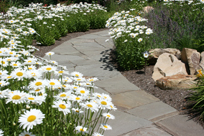pathways
Last time, Bruce Zaretsky discussed the importance of making a good first impression with a home’s landscape, starting with defining a pathway to the main entry. Here, he picks up that discussion while setting a broader front-yard stage. Today’s homes have many entries: front doors, service entries, back doors, garage doors and more. As a landscape designer, it is always my goal to
Every time I open a landscape trade magazine, I’m bombarded by ads from just about every paver manufacturer on the planet. From the newest faux-stone concrete pavers and ADA-compliant bricks to granite, flagstone, mica and other slab species, we have more choices than ever before for our projects. Some professionals approach this wealth of possibilities and play it safe – not caring so much about what’s the latest and greatest but focusing instead on what’s most familiar and time-tested and being interested in little more than providing clients with surfaces that can safely be walked on. Fortunately, however, there are lots of us who take a different view, putting care and thought into the materials we select for our walkways, patios and terraces and working closely with our clients to make certain the resulting surfaces meet their needs. In other words, there’s
Boston’s Big Dig was essentially a Big Fix. Officially known as the Central Artery Tunnel Project, it served to repair damage done to the heart of the city by the Interstate Highway program during the 1950s and ’60s. In Boston’s case, the federal government had stepped in and inserted a primary traffic artery through what had been a downtrodden area near the waterfront. Its intentions may have been good, but I-93 ran north to south and separated the city’s historic downtown area from its storied waterfront – a disastrous decision that did little more than create decades’ worth of traffic nightmares. Ultimately, it also required remediation on a scale seldom seen in the course of human history. Planning for the project began in 1982, initiating what would become
Not long ago, I did a pair of columns on healing gardens and their benefits. If you’ll recall, I preached the importance of persuading hospitals in particular to include these spaces in their overall site plans as a means of providing garden environments for patients, patients’ families and hospital staff: These spaces reduce stress, help patients heal more quickly and give everyone who visits them a soothing sense of tranquility. I’ve attempted to the greatest extent possible to practice what I preached, and through the years I’ve installed numerous health-specific gardens at local assisted-living centers, Alzheimer’s care facilities and even at a center for emotionally-challenged children. But truth be told, I haven’t met with much success with our local hospitals, despite the fact that healing gardens have caught on with countless such facilities coast to coast. I don’t know quite why this is, but we
In the often wild and woolly world of custom landscape and watershape design, it’s sometimes impossible to predict the sources of the most interesting and challenging projects – or anticipate how we manage to find our ways into the middle of them. It’s all part of what makes this profession so uplifting at times – and so confounding at others. I’ve worked hard to accept and embrace the strange tides of fortune this business entails. As a case in point, this month (and next) I’m going to relate a story that captures the essence of what it can take to accommodate the unexpected and enlist the nerve it sometimes takes to
My dictionary defines a rill as a small stream cut by erosion. In the practice of watershaping, however, that colorful little word has been stretched to cover manufactured channels in which we artfully move water from one place to another. These often-subtle effects have a history dating at least to the 5th Century BC, when Persian kings demonstrated their power over nature by using rills to bring water – a symbol of fertility as well as a practical means of cooling architectural spaces – from rivers and aqueducts to their palaces. These early rills were observed and adopted by Muslim designers and engineers who rose to eminence in the Middle East more than a millennium later and were carried along as Islamic influence spread through India, North Africa and, eventually, Spain, where signature elements of Moorish architecture are still seen today in the famous
Working on estate-sized residential projects is like assembling huge jigsaw puzzles in which all sorts of disparate pieces must ultimately fit together. While many of the individual parts have their own character and entail particular design and construction challenges, they're all part of a big picture you need to hold firmly in mind through every project phase. At GCS of Woodbridge, Calif., we pride ourselves on operating on a grand scale and on delivering the whole package, from landscape, hardscape, irrigation, control, communications, lighting and sound systems to watershapes of all sizes and types. Keeping all those elements sorted out within a single operation means we need to
Working on estate-sized residential projects is like assembling huge jigsaw puzzles in which all sorts of disparate pieces must ultimately fit together. While many of the individual parts have their own character and entail particular design and construction challenges, they're all part of a big picture you need to hold firmly in mind through every project phase. At GCS of Woodbridge, Calif., we pride ourselves on operating on a grand scale and on delivering the whole package, from landscape, hardscape, irrigation, control, communications, lighting and sound systems to watershapes of all sizes and types. Keeping all those elements sorted out within a single operation means we need to
When I was a kid, the conventional part of my education in environmental design came in helping my father, Jay Stang, plant parkways and blocks of Pinus Pinea across the city. The unconventional part - the part that apparently took firmer root as I grew up - had me admiring the plate he'd made from hardwood with the dozen split avocado pits he'd carved and mounted on the surface; it also had me listening to my mother, Judy Campbell, tell me that the earth was here first, that the garden already exists and that pathways, watershapes and structures are best built around what we find there. Those unconventional lessons - one about creativity and vision, the other about respect for nature and a method for approaching it - have stayed with me through the years and have given me access to a number of incredible projects. As is the case with most intriguing and fascinating designs, the one seen here flowed from a client with whom I developed a close creative connection that resulted in a free exchange of ideas¬ - a synchronized spontaneity that became a pattern for the entire design process. She always had strong thoughts about what she wanted, but she allowed me to interpret and express her ideas based on our conversations and the nature of the site. As designers, it's not unusual for us to be called on to use our skills and figure out what a client such as this one really wants and then suggest ideas we think will work. I call this process "environmental psychiatry" because, while so many clients have a sense of what they want and a laundry list of general ideas, few have a






















